| Pages:
1
2
3
4
..
6 |
bfesser
Resident Wikipedian
    
Posts: 2114
Registered: 29-1-2008
Member Is Offline
Mood: No Mood
|
|
I'm currently using an <a href="http://gstube.com/data/2398/" target="_blank">SBM-20</a> <img src="../scipics/_ext.png" /> in my
kit. I'm aware that the <a href="http://gstube.com/data/2486/" target="_blank">SI-3BG</a> <img src="../scipics/_ext.png" /> may be
less sensitive, but wanted a spare tube to tinker with, and couldn't resist the glass envelope and smaller form factor. Also, the kit's designed to
hold either an SBM-20, an SI-3BG, or an <a href="http://gstube.com/data/2480/" target="_blank">SI-1G</a> <img src="../scipics/_ext.png"
/> by soldering the clips to different pads—I plan to order extra <a href="https://en.wikipedia.org/wiki/Printed_circuit_board"
target="_blank">PCBs</a> <img src="../scipics/_wiki.png" />. I'm waiting on a <a
href="http://www.mouser.com/Search/ProductDetail.aspx?R=ROX0501G00FNLBvirtualkey61300000virtualkey71-ROX1/2-F-1G" target="_blank">1 GΩ
resistor</a> <img src="../scipics/_ext.png" /> I ordered from Mouser, so that I can <a
href="http://mightyohm.com/forum/viewtopic.php?f=15&t=487" target="_blank">adjust the high-voltage</a> <img src="../scipics/_ext.png"
/> properly. Until last week, I didn't even know that they produced resistors over 10 MΩ—I had never seen one before. I'm
sorely tempted to buy a <a href="http://www.ebay.com/itm/110990414351" target="_blanK">10 GΩ resistor</a> <img
src="../scipics/_ext.png" /> just to display on a shelf with a tag that reads "<img src="../scipics/_warn.png" />
<em>Achtung!</em> 10,000,000,000 Ohms <img src="../scipics/_warn.png" />." 
SBM-20 (top) vs. SI-3BG (bottom):

I hope to accumulate an entire collection of detection instruments, including G–M tubes, and related items. Maybe later I'll get out my
<a href="http://www.civildefensemuseum.com/cdmuseum2/radkits/cdv7772kit.html" target="_blank">CD V-777-2</a> <img
src="../scipics/_ext.png" /> for some photos. 
|
|
|
IrC
International Hazard
    
Posts: 2710
Registered: 7-3-2005
Location: Eureka
Member Is Offline
Mood: Discovering
|
|
Marvin, This may be useful to those experimenting:
http://www.hardhack.org.au/neutron_monitor
bfesser, do not touch that resistor -ever- or you will ruin it. Use Hemostats. On the leads near the body, not the body!
Also, those glass tubes suck. One I tried worked for a while at around 470 volts then died. Also they need very high radiation flux it appears. Either
the ones I tried needed a special circuit (I have yet to see in print) or they are not very sensitive and/or reliable. Higher voltages seem to ruin
them rapidly. Out of a handful I tried only one worked, for a short time. Their operating region seems to vary, then they fail.
Of the Russian surplus the tiny SBM-21 appears to be the most reliable and very sensitive. I built one counter using the SBM-21 with a flash unit I
hacked from a throw away camera. Powered by two AAA batteries in a tiny project box it is one of my favorite Geiger counters. Freaky how sensitive,
reliable, and overall very cool from a hardware hacker perspective this tube is to play with.
Here is an image I found on fleabay of the tube:
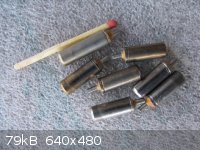
[Edited on 9-3-2013 by IrC]
"Science is the belief in the ignorance of the experts" Richard Feynman
|
|
|
bfesser
Resident Wikipedian
    
Posts: 2114
Registered: 29-1-2008
Member Is Offline
Mood: No Mood
|
|
Interesting, I had expected lower sensitivity, but hadn't considered the shielding effects of the glass. Also, I hadn't thought about the effects of
fingerprints on the resistor (if that is why you're warning me). Would it be alright to handle it with clean nitrile gloves—I tend to wear
them while soldering anyway? If not, I <em>do</em> have hemostats... I'm a geek, what can I say?
I doubt I'll get any accuracy regardless, with my shite <a href="http://www.radioshack.com/product/index.jsp?productId=2103176"
target="_blank">RadioShack multimeter</a> <img src="../scipics/_ext.png" />. I've been using the junky thing for years, and should
really invest in a better one (Fluke?).
[edit] <strong>IrC</strong>, I'm a little confused by the hardhack.org page you linked to. Is there more to it, or does their write up
just end with the 'specifications'? They seem provide a circuit diagram, and then no evaluation or conclusion. I can't seem to find anything
detailing the actual projects. I must be missing something...
[Edited on 3.9.13 by bfesser]
|
|
|
IrC
International Hazard
    
Posts: 2710
Registered: 7-3-2005
Location: Eureka
Member Is Offline
Mood: Discovering
|
|
Quote: Originally posted by bfesser  | | Also, I hadn't thought about the effects of fingerprints on the resistor (if that is why you're warning me). Would it be alright to handle it with
clean nitrile gloves—I tend to wear them while soldering anyway? If not, I <em>do</em> have hemostats |
Yes the chemicals coming off your skin gets into the surface of the resistor and not only alters the value, the value keeps changing with humidity.
Forever ruined. My hundred billion ohm resistors have been altered from much handling using even good gloves, thus my learned behavior of using
Hemostats on the leads only, close to the body. Held further down the lead torque is multiplied against the seal on glass body resistors. Not so bad
on some plastic body resistors. Unsure what the plastic is chemically, it matters in the hundred billion ohm range but no doubt that was taken into
account by the MFG.
"Is there more to it, or does their write up just end with the 'specifications'? They seem provide a circuit diagram, and then no evaluation or
conclusion"
Have not had time to really study the site. I see it from the perspective of what circuit I will design around the circuitry shown, although this
probably is of little use for those needing a completed project. To me I see what is needed to operate the tube and go from there.
I keep forgetting to mention but if hard to find high value resistors are needed, buy some old CDV-715'S. I just love hacker supplies.
[Edited on 9-3-2013 by IrC]
"Science is the belief in the ignorance of the experts" Richard Feynman
|
|
|
bfesser
Resident Wikipedian
    
Posts: 2114
Registered: 29-1-2008
Member Is Offline
Mood: No Mood
|
|
Interesting. Thank you so much for all of your advice on this subject, <strong>IrC</strong>. I'm just a novice in electronics, and I
greatly appreciate all of the effort and time you're expending in posting.
A bit off topic: You wouldn't happen to have a suggestion for an entry-level multimeter, would you? I've been following EEVblog on YouTube for a
while, and have learned a lot from it. I've been leaning toward an <a href="http://www.youtube.com/watch?v=bKvyoZa5J8Q" target="_blank">Agilent
U1272A or a Fluke 87 V</a> <img src="../scipics/_yt.png" /> (admittedly beyond entry-level, but I'm willing to invest once I find
employment).
I'm re-watching these:
<a href="http://www.youtube.com/watch?v=gh1n_ELmpFI" target="_blank">EEVblog #75 - Digital Multimeter Buying Guide for Beginners</a>
<img src="../scipics/_yt.png" />
<a href="http://www.youtube.com/watch?v=ZoeUgMFLyAw" target="_blank">EEVblog #91 - $50 Multimeter Shootout - Extech EX330, Amprobe AM220,
Elenco, Vichy VC99, GS Pro-50</a> <img src="../scipics/_yt.png" />
<a href="http://www.youtube.com/watch?v=n3WGaiYF2sk" target="_blank">EEVblog #99 - $100 Multimeter Shootout - Extech Amprobe BK Precision Ideal
UEi Uni-T</a> <img src="../scipics/_yt.png" />
[Edited on 3.9.13 by bfesser]
|
|
|
IrC
International Hazard
    
Posts: 2710
Registered: 7-3-2005
Location: Eureka
Member Is Offline
Mood: Discovering
|
|
I have dozens of DVM's in boxes. Only Flukes stay on my bench.
"Science is the belief in the ignorance of the experts" Richard Feynman
|
|
|
Plutonium239
Harmless

Posts: 10
Registered: 2-9-2013
Location: South Carolina
Member Is Offline
Mood: No Mood
|
|
I was aware of the cheap Russian tubes on eBay, but I never considered assembling my own neutron detector with them. Is a moderator required? I know
that fast neutrons are less likely to interact with particles, so should the tube be surrounded with borated paraffin? But then I would assume that
neutrons produced by bombarding beryllium with alpha particles are mostly in the thermal range, so I kind of doubt that it would even be needed for
this application.
|
|
|
IrC
International Hazard
    
Posts: 2710
Registered: 7-3-2005
Location: Eureka
Member Is Offline
Mood: Discovering
|
|
Yes you need a moderator.
For Neutrons to test it build this: Electron beam driven neutron generator
http://www.freepatentsonline.com/3968378.html
[Edited on 9-4-2013 by IrC]
"Science is the belief in the ignorance of the experts" Richard Feynman
|
|
|
Marvin
National Hazard
   
Posts: 995
Registered: 13-10-2002
Member Is Offline
Mood: No Mood
|
|
Has anyone actually made one? It looks tricky, assuming the principle works at all.
|
|
|
IrC
International Hazard
    
Posts: 2710
Registered: 7-3-2005
Location: Eureka
Member Is Offline
Mood: Discovering
|
|
I would guess if they did it would have been at Los Alamos or somewhere with an advanced lab.
"Science is the belief in the ignorance of the experts" Richard Feynman
|
|
|
12AX7
Post Harlot
    
Posts: 4803
Registered: 8-3-2005
Location: oscillating
Member Is Offline
Mood: informative
|
|
Easy:
http://www.electricalfun.com/WorkbenchFun/Fusor_William_Jack...
Though it didn't turn up in the first hits, I recall a webpage concerning amateur fusion efforts, with several examples needing only a source of
deuterium and tritium to generate neutrons.
Unfortunately, none of these are anywhere near overunity -- thermalization in the middle prevents desirable head-on collisions for the most part.
They can be used as portable neutron sources though.
Tim
|
|
|
phlogiston
International Hazard
    
Posts: 1379
Registered: 26-4-2008
Location: Neon Thorium Erbium Lanthanum Neodymium Sulphur
Member Is Offline
Mood: pyrophoric
|
|
bfesser, also consider that the resistance of the circuit board material becomes relevant when working with such high resistances. I used a 10Gohm
resistor to built a fast pico-ampere amplifier for use as a headstage in electrophysiology experiments (for recording the electrical activity of
single ion channels), and could not get it to work satisfactorily untill I built the critical part of the circuit in 'dead-bug style'
-----
"If a rocket goes up, who cares where it comes down, that's not my concern said Wernher von Braun" - Tom Lehrer |
|
|
bfesser
Resident Wikipedian
    
Posts: 2114
Registered: 29-1-2008
Member Is Offline
Mood: No Mood
|
|
Thanks, <strong>phlogiston</strong>, I had planned to <a
href="http://runawaybrainz.blogspot.co.uk/2012/04/audio-crystal-cmoy-freeform-headphone.html" target="_blank">freeform</a> <img
src="../scipics/_ext.png" /> or <a href="http://en.wikipedia.org/wiki/Point-to-point_construction#.22Dead_bug.22_construction"
target="_blank">dead-bug</a> <img src="../scipics/_wiki.png" /> it. The project is on hold until I can afford a decent multimeter.
|
|
|
Marvin
National Hazard
   
Posts: 995
Registered: 13-10-2002
Member Is Offline
Mood: No Mood
|
|
To use a fusor as a source of neutrons you don't need tritium, just deuterium. It's a large project on it's own. The glass mockup "demo fusors" are
not capable of neutron production, glass does not survive a proper run and a really good flowing vacuum system is required. fusor.net is the place to
go for more information.
|
|
|
IrC
International Hazard
    
Posts: 2710
Registered: 7-3-2005
Location: Eureka
Member Is Offline
Mood: Discovering
|
|
http://techlib.com/science/ion.html
Wanted to add this link but forgot where it was. Been a while since I went to this site. Anyway here it is. I have built everything on the page at one
time or another. Maybe bfesser will find a project He likes. Or :
http://www.vk2zay.net/article/265
http://circuitsalad.com/2012/11/19/a-solid-state-photodiode-...
http://www.techlib.com/science/ionchamber.htm
"Science is the belief in the ignorance of the experts" Richard Feynman
|
|
|
bfesser
Resident Wikipedian
    
Posts: 2114
Registered: 29-1-2008
Member Is Offline
Mood: No Mood
|
|
Great links, <strong>IrC</strong>. Thank you for sharing these. I especially like the techlib.com pages. I saw a similar page once on
soup can ionization chambers, but can't recall where I bookmarked it.
|
|
|
IrC
International Hazard
    
Posts: 2710
Registered: 7-3-2005
Location: Eureka
Member Is Offline
Mood: Discovering
|
|
I wanted to add the link to http://techlib.com long ago but could not remember the name and there are no embedded keywords that I could see to aid search engines. I was
looking at a Polonium pen I made a while ago and just could not remember where I found the plans for it. Oddly I was searching for picoamp photodiode
amplifier circuits for a gamma detector I was playing with and serendipitously one of the pages I found had a link to techlib. I recognized the name
the instant I saw it and just had to come back here and post it. Besides one of the most useful tools I ever built was the C-Beeper which I also found
on the site.
http://www.techlib.com/electronics/c_beeper.html
A guy running a cat digging a trench outside my building chopped a business line main cable (pulled about 100 feet of 100 conductor line out of the
ground, ripping it out leaving the end nearest me hidden underground). The phone company would not be able to fix it for 11 days as it was going to be
a major dig up a trench 400 feet to a junction box. No phone, no DSL, no internet. Phone no biggie people bother me anyway at the worst times. No DSL?
That was asking far too much. So I got the guy with the cat to help me measure out the stretch of cable, approximate where 3 feet down the end might
be, and dig until we found it. 110 feet of 2 conductor wire later I patched my pair, leaving the wire just laying on the ground. Only 2 wires in the
100 active (only me here now the other businesses long gone). Trusty Fluke one probe in dirt, testing junction box end, two wires showed voltage. At
my end inside using the C-Beeper it took mere seconds to find the right 2 wires.
I was going to comment on this the other day, then got busy and forgot about it. Has anyone studied the Krytron? I know, just a switch but years ago I
remember studying a neutron pulse tube patent (if I recall the number I'll post it) which was very similar except a sudden pulse of current drove
particles against an enriched LiD target deposited on a really thin Be window. In effect a Krytron type pulse assembly which directed a jet of
particles at high velocity against a target designed to produce neutrons for use in the Teller-Ulam design. Been a few years and I don't recall the
specifics, was it protons or Alpha particles, I will need to go find and study the patent again to be sure. In the meantime:
http://en.wikipedia.org/wiki/Neutron_generator
Or, what about building a Neutristor?
http://www.youtube.com/watch?v=fOsoueOIURo
http://arxiv.org/abs/1308.0327
Another page on neutron fun:
http://en.wikipedia.org/wiki/Neutron_source
Attachment: 1308.0327.pdf (206kB)
This file has been downloaded 923 times
[Edited on 9-11-2013 by IrC]
"Science is the belief in the ignorance of the experts" Richard Feynman
|
|
|
bfesser
Resident Wikipedian
    
Posts: 2114
Registered: 29-1-2008
Member Is Offline
Mood: No Mood
|
|
I can't wait until the neutristor becomes an off-the-shelf component! I wonder how long it will take them to develop a similarly small and simple
detector. Thanks for the links.
I finished a modification of my MightyOhm.com GC Kit last night and was going share my idea, but sadly the HV circuit died before I was able to test
it. The modification was on the LV side, and shouldn't have caused the malfunction. I think I may have fried the FJN3303F while adjusting the HV, so
I'm going to order some replacement parts from Mouser later today. Frustratingly, my multimeter died yesterday morning, so I can't even use that to
diagnose the failure.
[edit] I just found some photos on my camera that I will share.
<table><tr><td>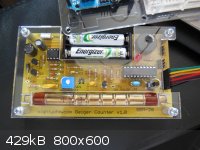 </td><td> </td><td>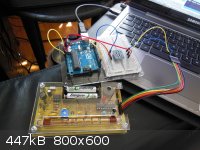 </td><td> </td><td>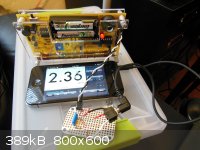 </td></tr><tr><td></td><td></td><td> </td></tr><tr><td></td><td></td><td> </td></tr></table> </td></tr></table>
On the left is a close-up of the counter with an SBM-20 G–M tube and NiMH batteries installed. A cable is attached from the serial header
to a <a href="http://adafru.it/757" target="_blank">level shifter</a> <img src="../scipics/_ext.png" />, shown clearly in the second
photo. I had the <a href="http://arduino.cc/en/Main/arduinoBoardUno" target="_blank">Arduino Uno</a> <img src="../scipics/_ext.png"
/> set up to relay the serial through USB to my laptop. In the third photo, you can see a prototype hardware interface which allows monitoring of
the pulse output of the kit in GeigerBot on an iPhone (below is a wiring diagram, adapted from <a
href="https://sites.google.com/site/diygeigercounter/geiger-bot-interface" target="_blank">here</a> <img src="../scipics/_ext.png"
/> . Inside the tote were a pair of thorium lantern mantles and my torbernite
& trinitite specimens. . Inside the tote were a pair of thorium lantern mantles and my torbernite
& trinitite specimens.
<strong>Note Regarding Arduino Serial:</strong>
Here's a nifty trick for anyone with an Uno but without a PC serial port or FTDI: Put a jumper between "RESET" and "GND" on the UNO and any (3.3-5V)
serial data fed to "TX → 1" will be relayed through USB to your computer. You can easily view the data using the <a
href="http://arduino.cc/en/Guide/Environment#serialmonitor" target="_blank">Arduino IDE Serial Monitor</a>, or capture it using <a
href="http://realterm.sourceforge.net/" target="_blank">RealTerm</a> <img src="../scipics/_ext.png" /> or a similar application.
<strong>Final Notes:</strong>
The modification I made was to include the interface circuit on a daughter-board inside the counter case. I'll try to post photos and an explanation
tomorrow. You can also connect the kit to a computer using any 3.3V compatible <a href="http://adafru.it/70" target="_blank">FTDI
cable</a> <img src="../scipics/_ext.png" /> or breakout. I recommend the <a href="adafru.it/284" target="_blank">FTDI
Friend</a> <img src="../scipics/_ext.png" /> by Adafruit, but others are available (<a href="https://www.sparkfun.com/products/9873"
target="_blank">SparkFun</a> <img src="../scipics/_ext.png" /> {mixed reviews}, <a
href="http://thecustomgeek.com/store/products/ftdi-ez-flex-adapter/" target="_blank">TheCustomGeek.com</a> <img src="../scipics/_ext.png"
/> {out of stock}). The MightyOhm.com Geiger Counter Kit can also be purchased <a href="http://adafru.it/483" target="_blank">from
Adafruit</a> <img src="../scipics/_ext.png" />, as well as <a href="http://adafru.it/561" target="_blank">the case</a> <img
src="../scipics/_ext.png" />. If you watch their <a href="http://www.youtube.com/playlist?list=PL7AE4BFB81D3DC925" target="_blank">Ask an
Engineer</a> <img src="../scipics/_yt.png" /> webcast on Saturday evenings at 10:00 p.m. EST (UTC-5), you can get a promotional code for
10% off. The kit+tube+case is currently on sale for 99.95 USD <a href="http://mightyohm.com/blog/products/geiger-counter/" target="_blank">from
MightyOhm.com</a> <img src="../scipics/_ext.png" />. You do the math.
[2nd edit] I used one of the cables from <a href="http://www.radioshack.com/product/index.jsp?productId=10797999" target="_blank">this
RadioShack product</a> <img src="../scipics/_wiki.png" /> for connecting the 3.5mm TRS socket on the prototype to the 3.5mm <a
href="http://en.wikipedia.org/wiki/Phone_connector_(audio)#TRRS_Standards" target="_blank">TRRS</a> <img src="../scipics/_wiki.png" />
iPhone jack—no clue as to the intended purpose, it was the cheapest I could find locally. My recently deceased multimeter's continuity test
function was used to verify the internal wiring (see diagram above).
[Edited on 13.9.13 by bfesser]
|
|
|
bfesser
Resident Wikipedian
    
Posts: 2114
Registered: 29-1-2008
Member Is Offline
Mood: No Mood
|
|
Quote: Originally posted by bfesser  | | I finished a modification of my MightyOhm.com GC Kit last night and was going share my idea, but sadly the HV circuit died before I was able to test
it. The modification was on the LV side, and shouldn't have caused the malfunction. I think I may have fried the FJN3303F while adjusting the HV, so
I'm going to order some replacement parts from Mouser later today. Frustratingly, my multimeter died yesterday morning, so I can't even use that to
diagnose the failure. |
Not that anyone but myself actually cares, but I got the kit working again. On a
hunch (call it <em><a href="http://www.youtube.com/watch?v=g8vHhgh6oM0" target="_blank">'the knack'</a></em> <img
src="../scipics/_yt.png" /> , I replaced the 2n3904 on the HV side with the last
one I had in my parts boxes, and it worked. I'm too tired to do a write up tonight, but here's a preview (turn your volume down): , I replaced the 2n3904 on the HV side with the last
one I had in my parts boxes, and it worked. I'm too tired to do a write up tonight, but here's a preview (turn your volume down):
<iframe sandbox width="420" height="315" src="//www.youtube-nocookie.com/embed/4gqPfqamrtA?rel=0" frameborder="0"
allowfullscreen></iframe>
|
|
|
dontasker
Harmless

Posts: 40
Registered: 19-12-2012
Member Is Offline
Mood: Plopping
|
|
Just thought I'd throw this out there. Found it while browsing hackaday. It's Arduino based, has a solid state detector, and color touch-screen display.
@bfesser
Looking forward to the write up!
|
|
|
IrC
International Hazard
    
Posts: 2710
Registered: 7-3-2005
Location: Eureka
Member Is Offline
Mood: Discovering
|
|
Bfesser it occurs to me to ask was the 3904 and your new meter dying related? As in a HV spike while checking voltages. No doubt the meter did not
come with a schematic but it may be possible to save it. I have blown several of my Flukes multiple times over the years, especially in my Tesla Coil
days. Every time I have managed to revive the meters by studying board and learning the locations of spike protection devices. Pulling one end loose
would bring back the voltmeter function. If that worked then replacing with a similar device. On those occasions the meter would still work in current
ranges so at least I knew the processor and A-D portions were OK. You might take it apart and look for parts from the voltage probe input to ground
and testing for short circuit. At least worth some study time and educated guessing as opposed to just chucking it in the hacker supply bin. Also find
something with a higher voltage rating than the 3904.
[Edited on 9-19-2013 by IrC]
"Science is the belief in the ignorance of the experts" Richard Feynman
|
|
|
bfesser
Resident Wikipedian
    
Posts: 2114
Registered: 29-1-2008
Member Is Offline
Mood: No Mood
|
|
Unrelated. The meter just blew a 500 mA fuse while I was trying to get a reading on the current draw of my vacuum pump. The only thing still
non-functional on it is the 'high-current' function (unfused). I don't recall it ever working, now that I think about it...
|
|
|
IrC
International Hazard
    
Posts: 2710
Registered: 7-3-2005
Location: Eureka
Member Is Offline
Mood: Discovering
|
|
Is there a circuit path of low impedance in high current range, i.e., a device functions just no reading? Does it display zeros? Maybe an omitted part
or cold solder junction in meter? Or if you take the meter apart and study the range switch do you see thick black oxide on contacts? You might try
spraying an electronic grade of cleaner/lubricant on the contacts while rotating the switch. Then spraying the board with Hexane such as CRC QD
electronic cleaner (Walmart) to get rid of oily residue.
"Science is the belief in the ignorance of the experts" Richard Feynman
|
|
|
bfesser
Resident Wikipedian
    
Posts: 2114
Registered: 29-1-2008
Member Is Offline
Mood: No Mood
|
|
<strong>IrC</strong>, I've been a bit distracted from it for the last week, but I'll take another look at it.
<hr width="80%" />
I stopped at the same antique shop (where I found the 'hot plate') today, and picked up a small "depression era" shot glass. The glass is quite thin,
and a strangely pleasing light green color. It's slightly radioactive (CPM noticeably elevated above background—no quantitative data).
Here are two photos; the first under standard illumination, and the second directly under my 254 nm UV lamp:
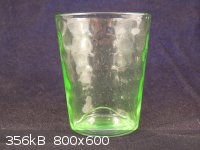 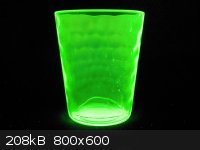
[edit] It's 48 mm in height and 39 mm max. OD—feels smaller than most shot glasses I've held. I might drink from it... but just once.
<a href="https://en.wikipedia.org/wiki/Depression_glass" target="_blank">Depression glass</a> <img src="../scipics/_wiki.png" />
<a href="https://en.wikipedia.org/wiki/Uranium_glass" target="_blank">Uranium glass</a> <img src="../scipics/_wiki.png" />
[Edited on 22.9.13 by bfesser]
|
|
|
plante1999
International Hazard
    
Posts: 1936
Registered: 27-12-2010
Member Is Offline
Mood: Mad as a hatter
|
|
So, bfesser, have you found some ore, or looked for them?
Or you are more of the shop guy, looking in stores for already gathered stuff?
Looking forward devlopement.
I never asked for this.
|
|
|
| Pages:
1
2
3
4
..
6 |